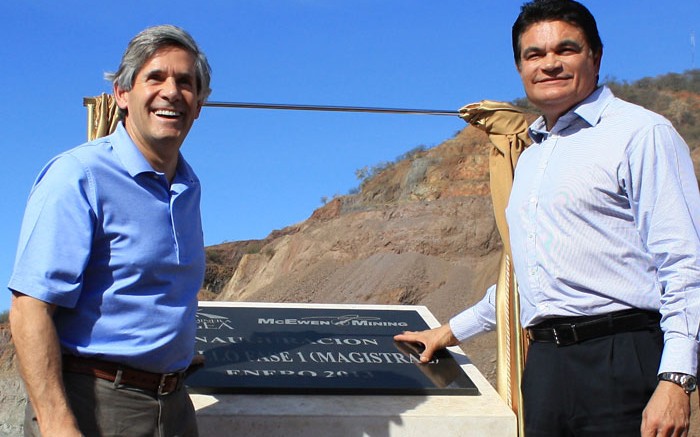McEwen Mining (MUX-T, MUX-N) has built one operating mine in Mexico, is in the midst of building a second that will start producing in mid-2014, and is actively exploring for more on its expansive 2.02-sq.-km El Gallo complex in Sinaloa state.
The company announced today it has made a new near-surface and high-grade discovery about 14 km west of El Gallo One and Two that it is calling Twin Domes. Initial drilling has returned intercepts of 4.6 metres grading 9.8 grams gold per tonne; 9.7 metres of 8.8 grams gold and 12.7 metres of 20.9 grams gold. A surface trench returned 12.7 metres running 20.9 grams gold, including a 1.7-metre intercept of 112.9 grams gold.
“These are the highest grades on the gold side that we have encountered so far at El Gallo,” Ian Ball, the company’s senior vice president, told The Northern Miner. “We’ll see if there’s more to it but the early indications are pretty good.”
Ball adds that the fact that the discovery was made under a farmer’s field is encouraging because a lot of agricultural land in the area has not seen any exploration. “When we’ve done flyovers we’ve seen a lot of hematite staining on farmers’ fields, which tells you there are mineral systems occurring below them.”
The mineralization at Twin Domes was uncovered to a depth of 50 metres across a strike length of 375 metres. The company is planning to complete ten trenches over the length of the mineralization to get a better grip on the geology, as well as a core drill program.
The plan is to go back and drill another four or five holes to confirm the orientation and then drill another three holes deeper, or below the existing ones. “We’ll start to see results in May if we’re lucky enough to encounter anything,” Ball says.
“One thing that has always been of interest to us is there has been a reasonable amount of high grade in the area — 180,000 ounces of gold was historically mined here at 20 grams per tonne between 1800 and 1950 — which is a good size for small-scale mining,” he continues. “Twin Domes is one of the first times we have seen grade comparable to that, so for us it’s very exciting…when you see grades approaching 100 grams per tonne you don’t need a lot of volume.”
Twin Domes was identified as a prospective target based on exploration by a predecessor company, which had discovered some rock samples showing some gold mineralization to the northwest. But they were looking in the wrong direction, Ball says.
“They drilled around the rock samples and didn’t encounter any meaningful mineralization,” he explains. “They then drilled where our exploration took place, but drilled generally in a different direction and below the zone that we encountered.”
“You can see from our holes that it took a little figuring out,” Ball admits. “That’s why we had to do the trench to help us get down to bedrock and help determine the orientation.”
The El Gallo I mine entered commercial production in January and will average 30,000 oz. gold a year over a mine life of seven and a half years at cash costs of US$800 per oz. The mine was built on time and at a cost of $13.5 million, about 10% under budget.
The El Gallo II mine will contribute another 105,000 oz. gold equivalent for a total of 135,000 oz. gold equivalent per year starting in the second half of 2014. The company anticipates having all three permits it needs to start building the mine before October.
The silver-rich El Gallo II mine will average annual production of 5.2 million oz. silver and 6,100 oz. gold in the first six and a half years, at a cash cost of US$9.86 per oz. silver net of gold by-products and including royalties, according to a feasibility study completed in September 2012.
In addition to Twin Domes, the company is exploring nine other prospects at El Gallo. Two of these, and the most advanced, are Haciendita and Mina Grande, about 10 km north of El Gallo II.
Geology in the region is dominated by a sequence of andesitic volcanic rocks, with a series of shallow-level intrusive rocks that penetrate the volcanic sequence. Each deposit in the El Gallo complex is different, but there is a common structural trend of northwest- and northeast-striking faults and mineralized zones. Each of the deposits are also said to host quartz veins, stockwork zones and breccias. Many are low-angle and dip shallowly, which make them attractive for open pit mining.
Adam Graf and Misha Leventhal of Dahlman Rose & Company in New York have a buy rating on McEwen Mining with a 12-month price target of US$8.75 per share.
At presstime in New York the company was trading at US$2.80 per share within a 52-week range of US$1.87-4.72. The company has about 300 million shares outstanding. In Toronto McEwen Mining was trading at $2.83 per share within a 52-week range of $2.02-4.92.


Be the first to comment on "More gold found at El Gallo"